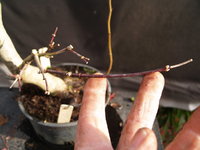Shibui
Imperial Masterpiece
I've often said I don't really like Bloodgood for bonsai because I can't get good structure or ramification.
These are a couple of trees I base my words on.
First up Bloodgood.
Opponents of grafted maples should take note of the trunk. Almost impossible to see the graft union on this tree but I know it's there because I made the graft around 12 years ago.



Just look at the internodes on this tree.


I know that excessive fert can make internodes longer than normal but I've tried almost everything with this tree to reduce internodes and leaf size but this appears to be the best I can do. It seems that Bloodgood just has large laves, long internodes and does not ramify well.
This is the best I've been able to manage in the way of structure and branching in the 12 years since starting this tree.

The only reason I've kept it this long is that Bloodgood has such a reputation as desirable.
After removing over thick branches and long internodes this is all I have for all those years of trying.

These are a couple of trees I base my words on.
First up Bloodgood.
Opponents of grafted maples should take note of the trunk. Almost impossible to see the graft union on this tree but I know it's there because I made the graft around 12 years ago.



Just look at the internodes on this tree.


I know that excessive fert can make internodes longer than normal but I've tried almost everything with this tree to reduce internodes and leaf size but this appears to be the best I can do. It seems that Bloodgood just has large laves, long internodes and does not ramify well.
This is the best I've been able to manage in the way of structure and branching in the 12 years since starting this tree.

The only reason I've kept it this long is that Bloodgood has such a reputation as desirable.
After removing over thick branches and long internodes this is all I have for all those years of trying.

















